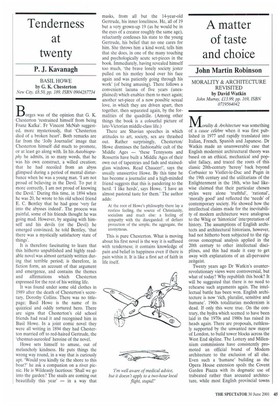A matter of taste and choice
John Martin Robinson
MORALITY & ARCHITECTURE REVISITED by David Watkin
John Murray, £13.99, pp. 169, ISBN 0719564042
Morality & Architecture was something of a cause dlebre when it was first published in 1977 and rapidly translated into Italian, French, Spanish and Japanese. Dr Watkin made an unanswerable case that English modernist architectural theory was based on an ethical, mechanical and populist fallacy, and traced the roots of this classic 20th-century 'heresy' back beyond Corbusier to Viollet-le-Duc and Pugin in the 19th century and the utilitarians of the Enlightenment in the 18th, who had likewise claimed that their particular chosen styles were alone 'truthful', 'rational', 'morally good' and reflected the 'needs' of contemporary society. He showed how the intellectual claims made for the inevitability of modern architecture were analogous to the Whig or 'historicist' interpretation of history. The assumptions of English architects and architectural historians, however, had not hitherto been subjected to the rigorous conceptual analysis applied in the 20th century to other intellectual disciplines, and this had made it easy to get away with explanations of an all-pervasive zeitgeist.
Twenty years ago Dr Watkin's counterrevolutionary views were controversial, but what of today? Why republish this book? It will be suggested that there is no need to rehearse such arguments again. The intellectual battle has been won. English architecture is now 'rich, pluralist, sensitive and humane'. 1960s totalitarian modernism is dead. If only this were true. On the contrary, the hydra which seemed to have been laid in the 1970s and 1980s has raised its heads again. There are proposals, ruthlessly supported by the unwanted new mayor of London, to build tower blocks across the West End skyline. The Lottery and Millennium commissions have consistently promoted an official brand of Modern architecture to the exclusion of all else. Even such a 'humane' building as the Opera House extension spoils the Covent Garden Piazza with its dogmatic use of trabeated rather than arcuated architecture, while most English provincial towns remain hideous, uninhabitable wastelands.
The RIBA maintains its stranglehold on the profession to encourage the careers of Modernists. As late as 1990 the RIBA blocked the grant of a knighthood to the widely admired classical-survival architect Francis Johnson. He was awarded a CBE only at the third attempt as a result of a direct appeal to the then prime minister, while Rogers of the Dome and Foster of the Wobbly Bridge have been given peerages. Most of the younger classical architects who showed promise in the 1980s have pursued their careers in America or on the Continent, or confined themselves to 'conservation'. They have received no public-funded commissions in England.
This new edition of Morality & Architecture, therefore, is timely. Even in 1977 opponents of the book pretended that Modernist doctrines were no longer widely held. Charles Jencks, for instance, claimed that 'David Watkin charges out on to the field . . . finds an enemy, with perfect aim delivers a mortal blow. But lo, the enemy is already dead.' Critics of the first edition were particularly affronted by the chapter on Sir Nikolaus Pevsner (who was then still alive), which they denounced as the 'kind of vindictiveness of which only Christians seem capable'. The appraisal of the bias in the work of an influential 20th-century art historian is, however, one of the more valuable and interesting aspects of this book, and now that Pevsner is dead, surely irreproachable? In an eye-opening prologue to this edition, entitled 'The Philosophic Background', Dr Watkin elaborates on this theme to show that Pevsner's ideas were partly the product of a 'progressive', moralistic outlook evolved in Germany from the writings of Hegel and Winkelmann which Pevsner had absorbed, perhaps unconsciously, from his supervisor at Leipzig University, the Nazi sympathiser Professor Wilhelm Pinder:
In great periods when ideology triumphs, architectural accomplishments are commissioned by the whole community and therefore will be morally good. It [architecture] should be the countenance of the Volk...
The original text of Morality & Architecture is here reprinted, but augmented with new preface, prologue and epilogue. The latter deals with the critical reaction to the original edition and makes fascinating, if frightening, reading. It quotes extensively from hitherto unpublished correspondence, including letters of support from Sir John Summerson, Sir Ernst Gombrich, Sir Karl Popper and other scholars, as well as from the published reviews. Interestingly, few of the distinguished figures who wrote privately to praise the book supported the author publicly from the amazing attacks he received. Bruno Zevi, editor of a leading Italian architectural journal, was only the most extreme in using words like 'stupid and obscene . . . wallowing in a cultural sewer. ... shit, vomit and spittle'.
Watkin's critics, however, despite resort
ing to immoderate and even hysterical abuse, failed to answer or overthrow his intellectual argument, an argument whose scholarly erudition is matched by a cool elegance of style. Watkin convincingly makes the case that good architecture is a matter of taste and individual choice and not an issue of moral essence or product of a collectivist zeitgeist. The new prolegomena continue the argument as well as defining the context. This important book is as valid today as when it was first published over 20 years ago, and this new, augmented edition is to be welcomed.











































































 Previous page
Previous page